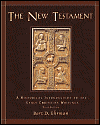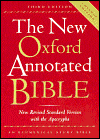|
|
|
In this course we will be examining the documents that comprise the New Testament (the second part of the Christian Bible) from a social and historical perspective. Our main goal in this course will be to understand the contexts from which the religious movement behind the New Testament emerged: the complex and conflicted mosaic of Jewish and gentile religions in the Ancient Near East and Mediterranean worlds, and the origins of the religion that would become Christianity.
This course is not a theological exploration of Christian "truth" nor is it an open "Bible study" in which students and professor will explore their personal beliefs in relation to Scriptures. There are appropriate times and places for such study: the University classroom is not one of them.
Instead we will use the particular tools of critical historical inquiry that have emerged in the past centuries in the academic study of the New Testament. "Reading critically" in this context does not mean to criticize: it means to read analytically and (as much as possible) objectively. We can read the texts of the New Testament sympathetically--as sincere documents emerging from and contributing to religious faith for many people around the world--without reading them merely as "believers." Likewise, we can read the New Testament texts analytically without reading them unsympathetically--as "fake" or insincere documents that no one should believe. Critical reading is both analytic and sympathetic.
The creation and dissemination of the New Testament, and the variety of religious movements behind it, will also lead us to ask more general questions about the nature of religion, culture, society, and texts:
These, and other questions, will drive our critical inquiry into the origins and spread of the documents that became known as the New Testament.
This is an upper-division course, which means that both the reading and assignments are designed to be more challenging and demanding than in a lower-division course. Please review all requirements and expectations for this class (including the readings listed below in the course schedule).
Grades for this course will be based on the following:
Course Participation (10%). Attendance in this class is mandatory (yes, I will be taking attendance). More than five absences will result in an automatic lowering of your participation grade. In addition, you are expected to have done all the required reading before coming in to class, and to be able to contribute to class discussions when called upon.
Response Papers (10%). You must write two response papers by the end of the quarter, choosing from the four response paper topics listed below in the course syllabus (more information and guidelines for response papers can be found on the course website). These response papers are analytical responses to a particular reading or set of readings from the New Testament and early Christian documents.
Essay Paper (25%). An essay paper, engaging in a comparative reading of multiple New Testament documents, is due on the last day of class (you may turn it in early, if you like). You have three choices for this essay paper:
Specific guidelines (including page length and other formatting concerns, as well as tips for writings an extended essay paper on the New Testament) will be found on the course website.
Midterm Examination (25%). An in-class examination covering the first half of the course will be given on Wednesday, February 15.
Final Examination (30%). The final examination, covering the entire quarter, will be given on March 20.
You should be familiar with UCRs regulations on academic honesty and plagiarism (available online: http://senate.ucr.edu/bylaws/PDF Files/P3 Ch6.pdf); any instance of cheating or plagiarism will be punished with a zero grade and will be referred to the University administration for reprimand.
Textbook.
Bart D. Ehrman, The New Testament: A Historical Introduction to the Early Christian Writings, 3d ed. New York: Oxford University Press, 2003. [NTHI]
Bible.
I have ordered the New Oxford Annotated Study Bible for this class: it is an excellent translation, with many helpful maps, timelines, essays, notes, and other supplementary resources. It is highly recommended that you purchase and use this Bible for class. If you already have a Bible you would like to use, please see the professor to determine if it is a reliable translation. There are also links to online translations of the Bible on the course website (go to the Links page).
Additional materials. Some readings for this course are found on the internet. To obtain these readings, go to the course website, click on "Syllabus & Readings," and scroll down to the reading assignment and click on the link. Links to further online resources, as well as additional study guides prepared for this class, can be also found on the course website.
The website for this course is [link removed]
All relevant information for this course--including details on written assignments, study guides for exams, links to online readings--must be accessed through this website. All announcements pertaining to the course will also be posted on the home page of the course website.
There is also a Blackboard site for this class (go to [link removed] and use your email ID and password to log on; then click on the link for RLST 130). The only functions activated for the Blackboard site are: announcements, communication, and discussion forum. All announcements for the course will be posted on the Blackboard site, and the professor will also make use of the communication function if he needs to email the entire class (you must check your student email account regularly). In addition, if you wish to post questions or continue class discussions outside of class, you are encouraged to use the discussion forum feature of the Blackboard site. (You can post anonymously, but that capability will be removed if it is abused.)
Mark your calendars now! Due dates for Response Papers (choose two): January 18, January 30, March 3, March 13 In-class midterm: February 15 Essay paper due: March 17 Final Exam: March 20 |
|
|








